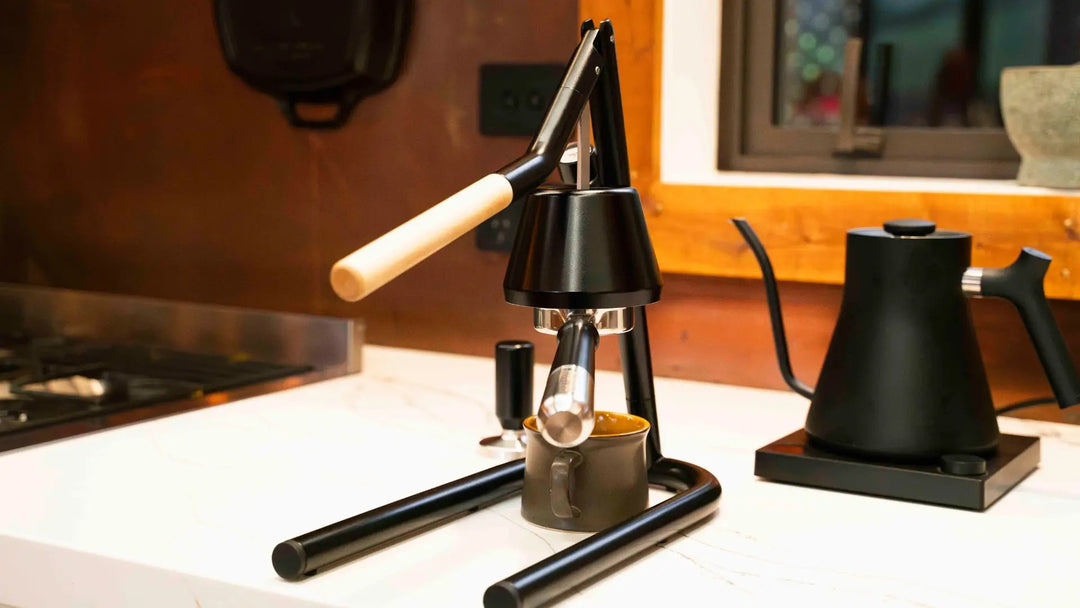Manual espresso maker buying guide: Find the perfect machine

Welcome to Newton Espresso's comprehensive guide to choosing the perfect manual espresso maker. We understand that selecting the right espresso machine can be a daunting task. That’s why we’ve created this guide to help you navigate the world of manual espresso and discover the ideal machine to support your home brewing experience. We're confident that with the right knowledge, you can unlock the potential to create barista-quality espresso right in your kitchen.
Why choose a manual espresso maker?
Manual espresso makers offer a unique level of control and engagement that other types of espresso machines simply can't match. If you're passionate about coffee and enjoy the hands-on process of crafting the perfect shot, a manual machine is an excellent choice. Unlike automatic or semi-automatic machines, manual espresso makers put you in complete command of the brewing process, allowing you to experiment with pressure, temperature, and extraction time to achieve your desired flavour profile. With a manual espresso maker, you can fine-tune every variable to create a truly personalised coffee experience.
At Newton Espresso, we believe in the power of simplicity and control. Our latest (and best) espresso maker yet, the Brua3 Max, embodies these principles, offering exceptional performance and durability in a beautifully designed package. Our manual lever espresso machine allows you to truly connect with the art of espresso making.
Key considerations when buying a manual espresso maker
When embarking on your manual espresso maker buying guide journey, consider these essential factors to ensure you make an informed decision:
Build quality and materials
The durability and longevity of your manual espresso maker depend on its build quality and the materials used. Look for machines constructed from high-quality materials such as stainless steel, which is known for its resistance to corrosion and its ability to withstand high pressure and temperatures. The Brua3 Max features a robust construction with a 5 year warranty on all metal components, ensuring years of reliable performance.
Pressure and extraction
Optimal pressure is crucial for extracting the full flavour potential of your coffee beans. Manual espresso makers typically allow you to generate pressure through a lever system. Look for a machine that enables you to achieve and maintain consistent pressure throughout the extraction process. Our Brua3 Max utilises a direct lever design which gives you complete control over pressure profiling, allowing you to enhance flavours and customise your espresso.
Temperature stability
Maintaining a stable water temperature is essential for consistent espresso extraction. The insulated brew chamber design of the Brua3 Max provides exceptional thermal stability without the need for electric heating, ensuring that the water remains at the ideal temperature throughout the brewing process. This results in a more balanced and flavourful espresso shot.
Ease of use and maintenance
While manual espresso makers offer a rewarding brewing experience, they should also be relatively easy to use and maintain. Look for a machine with a simple and intuitive design, as well as easily cleanable components. The Brua3 Max is designed for easy cleaning and low maintenance, allowing you to focus on enjoying your espresso rather than struggling with lots of separate parts and complicated cleaning procedures.
Size and footprint
Consider the size and footprint of the manual espresso maker, especially if you have limited counter space. The Brua3 Max has a compact design (L 300mm x W 175mm x H 350mm), making it suitable for home use without taking up too much space. The assembled weight is appropriately 3.5kg.
Below is a quick reference table about the Brua3 Max:
|
Feature |
Details |
|
Brew Capacity |
90ml cylinder |
|
Extraction Output |
Up to 65ml |
|
Weight |
3.5kg |
|
Portafilter Size |
58mm / E61 |
Essential accessories for your manual espresso maker
To fully optimise your manual espresso brewing experience, consider investing in these essential accessories:
-
Coffee grinder: A high-quality burr grinder is essential for achieving a consistent and uniform grind size, which is crucial for proper espresso extraction. Consider our Manual Coffee Grinder for the best results.
-
Coffee distributor: A coffee distributor ensures even distribution of coffee grounds in the portafilter, preventing channeling and promoting uniform extraction. We offer coffee distributors made from anodised aluminium + polished stainless steel that will fix poor puck prep in no time.
-
Espresso tamper: A tamper is used to compress the coffee grounds in the portafilter, creating a dense and even puck.
-
Coffee scale: Precision is key for espresso brewing, so a digital coffee scale is essential for measuring both coffee grounds and espresso yield. The Digital Coffee Scale + Timer will help you dial in that perfect shot.
-
Puck screen: A puck screen helps distribute water evenly over the coffee puck, preventing channeling and improving extraction by protecting the integrity of the coffee grinds. Our Espresso Puck Screen will last a lifetime and is the fastest way to improve your espresso at home.
-
Barista cloth: Keep your workspace clean and tidy with a durable barista cloth. Our Black Microfibre Barista Cloth won't show coffee stains, cleans all your coffee mess and is perfect for maintaining your manual espresso maker.
Choosing the right manual espresso maker for your needs
Selecting the right manual espresso maker depends on your individual needs and preferences. Here's a breakdown of different types of manual espresso makers and their characteristics:
Lever espresso machines
Lever espresso machines can be broken down into two types - direct lever and spring lever espresso makers. A spring lever design uses a lever to compress a spring that is then used to drive consistent pressure to the piston. Direct lever espresso makers, however, like our Brua3 Max, use a lever directly attached to the piston to manually generate pressure, allowing for pressure to be increased or decreased during the extraction. These machines offer unparalleled control over the brewing process, allowing you to experiment with pressure profiling and fine-tune your espresso to perfection.
Direct lever machines are ideal for home baristas who enjoy the hands-on approach and appreciate the nuances of making espresso. This manual espresso maker buying guide choice is trusted by 1000's of coffee enthusiasts.
Pneumatic espresso makers
Pneumatic espresso makers use air pressure to extract espresso. There’s no lever as you'd expect for a lever machine; pressure is applied by other manual means pump, button, toggle, etc.
Stovetop coffee makers
A stovetop espresso maker uses an element to heat a water reservoir, generating high pressure which then forces the now hot water through the coffee grind.
Tips for brewing the perfect manual espresso
Once you've chosen your manual espresso maker, follow these tips to brew the perfect shot every time:
-
Use fresh, high-quality coffee beans: Freshly roasted beans are essential for optimal flavour.
-
Grind your beans just before brewing: Grinding beans right before brewing helps to preserve their aroma and flavour.
-
Use the right grind size: The grind size should be fine enough to create resistance, but not so fine that it clogs the portafilter.
-
Tamp evenly and consistently: Apply even pressure when tamping to create a dense and uniform coffee puck.
-
Pre-infuse your coffee: Pre-infusion involves wetting the coffee grounds with the hot brew water at low pressure before applying full pressure. This allows the coffee to bloom and improves extraction.
-
Monitor the extraction: Pay attention to the colour and flow of the espresso as it extracts. Stop the extraction when the espresso starts to blonde or turn watery.
Maintaining your manual espresso maker
Regular maintenance is essential for keeping your manual espresso maker in top condition. Follow these tips to ensure years of reliable performance:
-
Clean the portafilter and basket after each use: Remove any coffee grounds and rinse with hot water.
-
Flush your machine regularly: Flushing helps to remove coffee oils and residue from the group head. This is easy with the Brua3 Max - simply remove the portafilter and run hot water through the machine as you would to preheat.
-
Descale your machine regularly: Descaling removes mineral buildup from the boiler and other components.
-
Replace worn parts as needed: Replace any worn seals, gaskets, or other parts to maintain optimal performance.
Join the Newton Espresso community
We invite you to join the Newton Espresso community and share your passion for manual espresso brewing. Connect with us on social media, share your brewing tips and recipes, and tag us in your photos. We love seeing how our customers are using our machines to create amazing coffee at home. We are always seeking collaborations with content creators and coffee influencers to expand our reach!
Conclusion: Enhance your coffee experience with a manual espresso maker
Choosing a manual espresso maker is an investment in your coffee journey. With its unparalleled control, simplicity, and durability, the Brua3 Max is an excellent choice for coffee enthusiasts who want to create barista-quality espresso at home. And if you sign up for our mailing list, you'll receive a 10% discount code you can use immediately!
We hope this manual espresso maker buying guide has been helpful in your search for the perfect machine. At Newton Espresso, we're committed to providing our customers with the tools and knowledge they need to brew exceptional espresso. We offer complimentary worldwide shipping and easy 14 day returns.
FAQ about manual espresso makers
What are the benefits of using a manual espresso maker?
Manual espresso makers offer a high degree of control over the brewing process, allowing you to fine-tune every variable and create a truly personalised coffee experience. They are also often more durable and long-lasting than automatic machines.
How much pressure should I use when brewing espresso with a manual machine?
The ideal pressure for espresso brewing is typically around 9 bars. However, with a manual machine, you can experiment with different pressure levels to achieve your desired flavour profile. Some experienced home baristas are now promoting a 6 bar pressure extraction.
What is pre-infusion, and why is it important?
Pre-infusion involves wetting the coffee grounds with hot water before applying full pressure. This allows the coffee to bloom and improves extraction. It is done as part of the extraction process, only minimal pressure is applied for 5-8 seconds before applying full extraction pressure.
How often should I clean and maintain my manual espresso maker?
You should clean the portafilter and basket after each use, flush your machine regularly (weekly), and descale it as needed to remove mineral buildup.
What is the ideal grind size for manual espresso brewing?
The grind size should be fine enough to create resistance, but not so fine that you can't (relatively) easily force water through it. Experiment with different grind sizes to find the sweet spot for your machine and coffee beans.
Where can I buy accessories for my Newton Espresso machine?
We sell a wide range of accessories on our website, including coffee grinders, distributors, tampers, and more. Visit our manual coffee maker accessories page to browse our selection.




